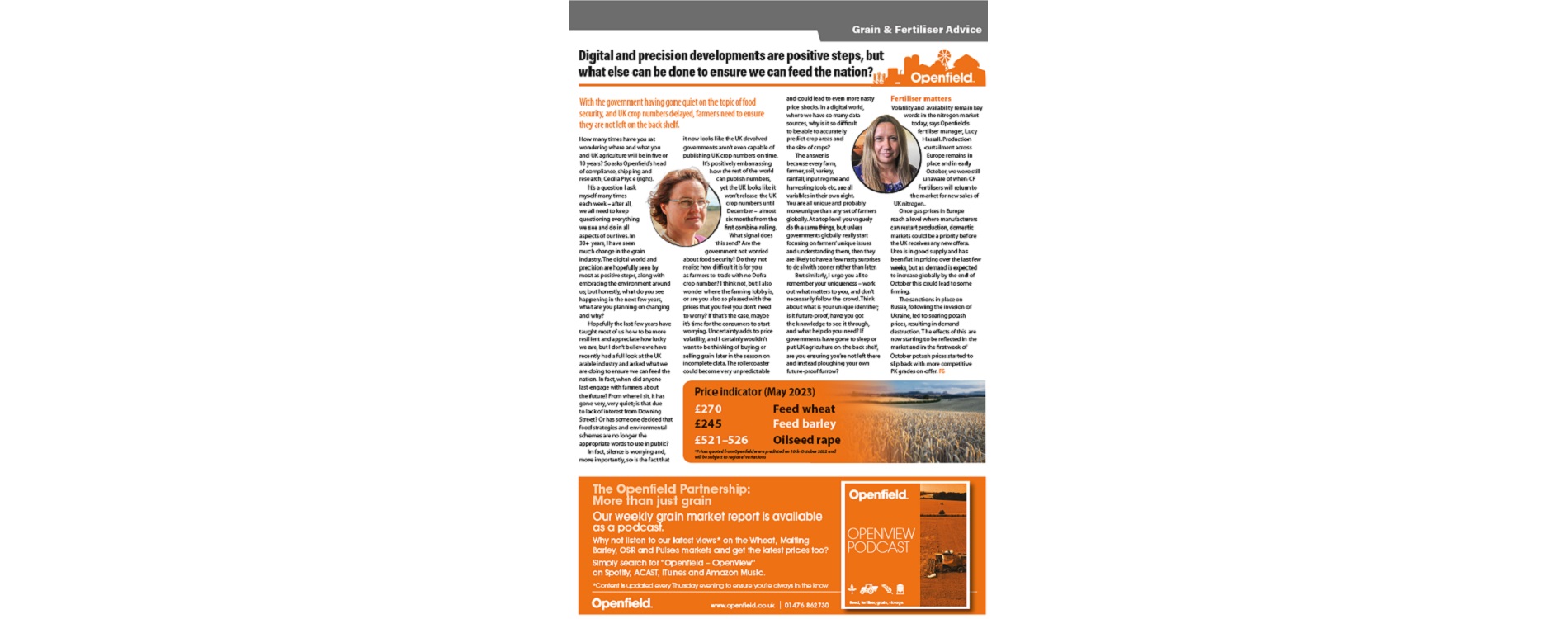Data and knowledge move markets – so why can’t the UK produce a crop number?
The market volatility is huge domestically and globally, yet there seems no urgency to help the UK agriculture industry with more timely releases of data or even an update on the future of ELMS.
By the time you read this we will have traded almost six months of the 2022/23 grain year. I feel it’s safe to say it’s been like no other season and that all in the industry have had to deal with many curve balls. Harvest was early, fast, and dry for many, with crops performing better than expected given the weather, but there is still much debate around the size of the main crops. This point is one that disappoints me every year. How come the rest of the world can confidently produce a crop number in a timely manner but the UK, with all our gizmos and knowledge, still has to wait until 15th December. The market volatility is huge domestically and globally, yet there seems no urgency to help UK agriculture with more timely releases of data and even an update on the future of ELMS.
It’s also amazing how HM Customs and Excise Trade Data is still on a two-month lag, yet the rest of the world is publishing pretty much ‘real time’ data. Yes, there may be some retrospective corrections, but with digital customs entries you can’t tell me we can’t speed up the flow of information! Luckily for us, much of the rest of the world is better at statistics, so at least we will have data to show what ships are coming this way in real time, courtesy of other nations and their data. It’s data and knowledge that moves markets and the real time data that is currently showing from the Ukraine grain corridor is probably one of the largest “market stabilisers” that there is. Anything that has been shipped is recorded and it’s impressive.
The three Ukraine ports shipped 4.2 million tonnes of commodities in October, which shows where there is a will or a contract, and the price is right, anything is possible. From the first ship that sailed on 1st August to the end of November, 506 ships departed, carrying a total of 12.337 million tonnes of 17 commodities going to 29 different countries. I know it’s a UN initiative, but it proves data is available and this adds stability to markets. The world called for a solution to a problem and it happened; but what happens next? The corridor has been extended for another 120 days, but how much more tonnage has Ukraine got to ship? Again, the world needs data in order to decrease price volatility and restore confidence that there really is enough to go around and literally feed the world. The world’s population keeps expanding, the politics seem to take up more and more time, but grain is largely a freemarket product that trades globally from countries in surplus to those in deficit.
The Ukraine has travelled a very difficult path since the breakup of the Soviet Union in 1991, as have the EU Agricultural Policies; and now the UK stands on its own post-Brexit, I wonder what we are capable of with poor data? We have seen taxes, quotas and export licences but as the world moves forward, we all know that cereals and oilseeds are a very basic necessity for any and all countries globally. We don’t know what will happen in the future, but no country can afford to forget about food security and the need for timely accurate data in order to prevent price volatility. I feel we may currently be asleep at the wheel which may cause issues soon!
Fertiliser matters
Phosphate and potash are vital nutrients for maximising yield potential. This season, due to costs, some growers may be considering reducing PK inputs and adding risk to yield potential. Whilst not advising a cut back of PKs, supplying some fresh readily available nutrient at peak uptake may partially help to reduce the risk. Applying NPKS compounds is an efficient way of doing this by giving the crop a fresh dose of phosphate and potash, along with the nitrogen and sulphur when demand is greatest. Early applications give crops the best possible start in the spring, as they look to put on growth before soils are warm enough to mineralise nutrient. Also, with NPKS compounds every granule contains a consistent amount of all nutrients; not only this but you are also increasing the number of sites per square metre, particularly important as phosphate has such limited mobility and a good coverage is essential.




